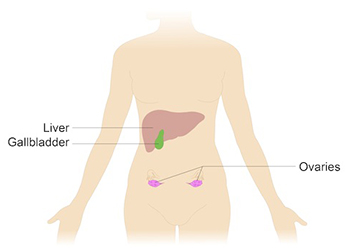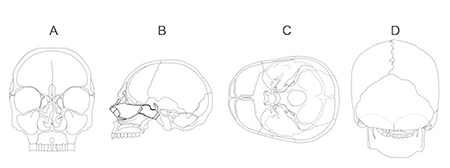26 Human Anatomy Questions
Question Description
1.
(01.01 LC)
Gross anatomy is the study of (2 points)
| bodily structures that are visible only with a microscope |
| bodily structures that are visible with the naked eye |
| the chemical and physical processes of the body |
| the function of body systems, organs and tissues |
2.
(01.01 MC)
Which of the following activities would most likely be done by a physiologist? (2 points)
| Studying how bones, ligaments, tendons, and muscles create movement |
| Researching the density of human bones compared to gorilla bones |
| Comparing the hearts of people suffering from different heart diseases |
| Examining the different layers of the heart tissue |
3.
(01.02 MC)
A medical student makes a transverse cut of a cadaver’s leg. The two resulting sections could be referred to as the (2 points)
| superior and inferior sections |
| anterior and posterior sections |
| left and right sections |
| frontal and sagittal sections |
4.
(01.02 MC)
Which of the following is an example of homeostasis? (2 points)
| Food being digested in the stomach |
| The lungs expanding during inhalation |
| The body being warmed by shivering |
| The leg muscles contracting during walking |
5.
(01.02 MC)

© Image Courtesy of 3DScience.com 2013
Based on the diagram, the gallbladder can be considered ______________ and the ovaries can be considered _______________ in reference to the body’s midline. (2 points)
| bilateral; lateral |
| medial; superior |
| lateral; bilateral |
| medial; posterior |
6.
(01.02 MC)

© Image Courtesy of 3DScience.com 2013
An anatomist needs to cut a skull open with a transverse cut. Which of the diagrams correctly shows how the cut should appear? (2 points)
| A |
| B |
| C |
| D |
7.
(01.03 MC)
Injury to which tissues will greatly reduce the ability of a person to move his or her limbs? (2 points)
| Skin |
| Epithelial |
| Muscle |
| Stem cell tissue |
8.
(01.03 MC)
A person develops a disease that reduces cell communication within the body. This disease most likely targets the ____________ tissue. (2 points)
| muscle |
| epithelial |
| nervous |
| connective |
9.
(01.03 MC)
In creating a replacement organ using stem cells, a doctor first creates a replica of the patient’s current organ. This is necessary to (2 points)
| induce the stem cells to grow into the proper tissue and organ type |
| induce the stem cells to create an organ of the appropriate size and shape |
| mimic the conditions within the patient’s body, allowing the stem cells to survive |
| occupy the space of the old organ while the new organ is being transplanted |
10.
(01.03 MC)
Many researchers hope pig organs will one day be successfully transplanted to humans. What would an advantage of successful pig-human transplants? (2 points)
| Using pig organs could reduce the shortage of human organs. |
| Using pig organs could increase immunity to certain diseases. |
| Pig organs will not be rejected by the receiver’s immune system. |
| Pig organs can be used for every future transplant procedure. |
11.
(01.03 MC)

© Image Courtesy of 3DScience.com 2013
| Layer of Skin | Description |
|---|---|
| Epidermis | Layered sheets of tightly packed cells that divide readily; poor blood supply |
| Dermis | Good blood supply; has nerve endings |
| Hypodermis | Contains fatty layer for cushioning; good blood supply; has nerves |
Based on the information in the table and diagram, which of the following is true? (2 points)
| The epidermis contains epithelial tissue. |
| Connective tissue can be found in all three layers of skin. |
| Only the epidermis and dermis contain nervous tissue. |
| The hypodermis contains only epithelial and nervous tissue. |
12.
(01.03 MC)

© Image Courtesy of 3DScience.com 2013
The diagram above shows where different types of tissues are found in the body. Based on the information in the image, where else may skeletal muscle be found in the body? (2 points)
| Legs |
| Glands |
| Intestines |
| Heart |
13.
(01.03 MC)
Osteoarthritis is a disease that results in a thinned or absent layer of cartilage surrounding bones, causing bones to rub against one another. This causes both pain and loss of motion. Given this information, what type of tissue does osteoarthritis affect? (2 points)
| Connective |
| Muscular |
| Epithelial |
| Nervous |
14.
(01.03 MC)
A gland is an organ that synthesizes and releases a substance. There are two major types of glands: endocrine and exocrine. In some cases, the substance released by a gland lubricates tissues of the body that are commonly abraded. For example, mucus glands secrete mucus to help lubricate the passage of food through the digestive tract. Given this information, which type of tissue will likely contain mucus glands? (2 points)
| Epithelial |
| Connective |
| Muscle |
| Nervous |
15.
(01.03 MC)
Certain drugs, known as angiogenesis inhibitors, are effective anti-cancer drugs because they cut off the blood supply to tumors. Without blood supplying fresh oxygen and nutrients to the cancerous cells, the tumors cannot survive. Given this information, angiogenesis inhibitors will be least effective in treating tumors in (2 points)
| epithelial tissue |
| connective tissue |
| nerve tissue |
| muscle tissue |
16.
(01.05 LC)
The clavicle is likely part of the appendicular system because it is involved with movement of the (2 points)
| arm |
| rib |
| spine |
| head |
17.
(01.05 LC)
The axial skeleton includes the (2 points)
| vertebra, skull, and ribs |
| hip bones, knees, and feet |
| shoulder bones, elbows, and hands |
| bones of the fingers and toes |
18.
(01.05 MC)
Which of the choices below only contains bones of the pectoral girdle? (2 points)
| Scapula; clavicle |
| Hip bones; femur |
| Femur; tarsus |
| Humerus; radius |
19.
(01.05 MC)
The carpals are _____________bones found in the ___________________. (2 points)
| long; axial skeleton |
| irregular; axial skeleton |
| flat; appendicular skeleton |
| short; appendicular skeleton |
20.
(01.06 LC)
Nutrients are brought to compact bone through which mechanism? (2 points)
| diffusion through the bony matrix |
| diffusion through canaliculi |
| transport through Haversian canals |
| transport through collagen fibers |
21.
(01.06 LC)
Osteons are the basic organizational units of (2 points)
| spongy bone |
| compact bone |
| bone marrow |
| procalluses |
22.
(01.06 MC)
Low calcium levels in the blood can be raised by dissolving bone tissue. Which cell would most likely be involved in this process? (2 points)
| Osteoblasts |
| Osteocytes |
| Osteoclasts |
| Osteogenic cells |
23.
(01.06 MC)
You are a doctor who examines the x-ray of a broken bone, which is healing. What should you look for to indicate that the break is almost completely healed? (2 points)
| Procallus |
| Hematoma |
| Compact bone |
| Spongy bone |
24.
(01.06 MC)
You are an anthropologist analyzing bone remains from the grave of an ancient female human. Within one of the bones, you find an unusually high concentration of collagen. What does this suggest about the ancient female? (2 points)
| She broke a bone and then died before it was fully healed. |
| She broke a bone and then died a few hours later. |
| She broke a bone at a very young age, but it fully healed. |
| She broke a bone at a very young age, but it did not fully heal. |
SHORT ANSWERS:
25.
(01.03 HC)
Bone marrow is a soft, spongy, connective tissue found inside bones. Bone marrow contains stem cells, which can generate new blood cells and, therefore, can treat many diseases of the blood. In the past, extracting bone marrow from a donor required anesthesia and a long, large needle. The process often discouraged people from signing up to be donors. A process called apheresis has made the process much less painful and invasive. In apheresis, the donor’s blood passes through a sterile line into the machine. Once the blood is inside the machine, the bone marrow stem cells are extracted, and the remaining blood is returned to the donor. Donors typically only experience minor discomfort from the needles used and the loss of electrolytes.
Describe how you think this advance in biotechnology will affect individuals and society. Be sure to include any potential medical or ethical issues that could arise from this new practice. (5 points)
26.
(01.04 MC)
Describe how our skin darkens in the presence of sun. In your description, be sure to name the pigment that darkens our skin and describe how skin darkening protects our DNA from damage. (5 points)
Do you need a similar assignment done for you from scratch? We have qualified writers to help you. We assure you an A+ quality paper that is free from plagiarism. Order now for an Amazing Discount!
Use Discount Code "Newclient" for a 15% Discount!
NB: We do not resell papers. Upon ordering, we do an original paper exclusively for you.


